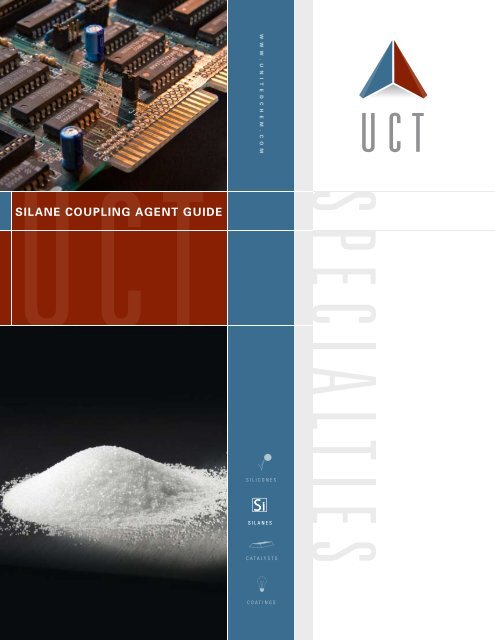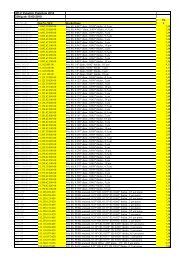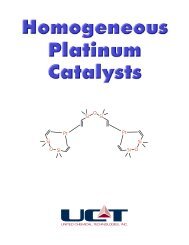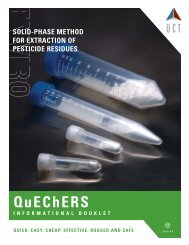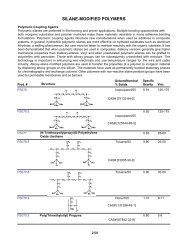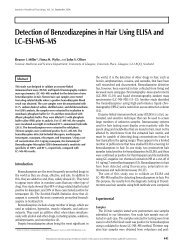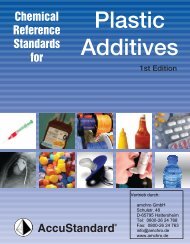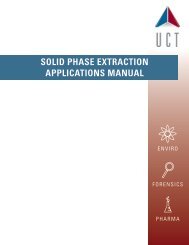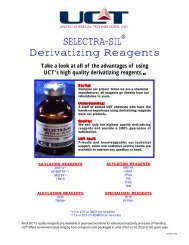SILANE COUPLING AGENT GUIDE
SILANE COUPLING AGENT GUIDE
SILANE COUPLING AGENT GUIDE
You also want an ePaper? Increase the reach of your titles
YUMPU automatically turns print PDFs into web optimized ePapers that Google loves.
w w w . u n i t e d c h e m . c o mUCTOUCT<strong>SILANE</strong> <strong>COUPLING</strong> <strong>AGENT</strong> <strong>GUIDE</strong>SILICONES<strong>SILANE</strong>SCATALYSTSCOATINGS
<strong>SILANE</strong> <strong>COUPLING</strong> <strong>AGENT</strong> CHEMISTRYThe general formula of an organosilane shows two classes of functionality.RnSiX(4-n)The X functional group is involved in the reaction with the inorganic substrate. The bondbetween X and the silicon atom in coupling agents is replaced by a bond between the inorganicsubstrate and the silicon atom. X is a hydrolyzable group, typically, alkoxy, acyloxy, amine, orchlorine. The most common alkoxy groups are methoxy and ethoxy, which give methanol andethanol as byproducts during coupling reactions. Since chlorosilanes generate hydrogen chlorideas a byproduct during coupling reactions, they are generally utilized less than alkoxysilanes.R is a nonhydrolyzable organic radical that possesses a functionality which enables thecoupling agent to bond with organic resins and polymers. Most of the widely used organosilaneshave one organic substituent.In most cases the silane is subjected to hydrolysis prior to the surface treatment. Followinghydrolysis, a reactive silanol group is formed, which can condense with other silanol groups, forexample, those on the surface of siliceous fillers, to form siloxane linkages. Stable condensationproducts are also formed with other oxides such as those of aluminum, zirconium, tin, titanium,and nickel. Less stable bonds are formed with oxides of boron, iron, and carbon. Alkali metal oxidesand carbonates do not form stable bonds with Si – O –.Water for hydrolysis may come from several sources. It may be added, it may be presenton the substrate surface or it may come from the atmosphere. Water for hydrolysis may also begenerated in situ by dissolving chlorosilanes in excess alcohol. Reaction with alcohol producesalkoxysilanes and HCl, which can react with additional alcohol to form an alkyl halide and water.Reaction of these silanes involves four steps. Initially, hydrolysis of the three labile Xgroups attached to silicon occurs.RSi(OMe) 33H 2 O 3MeOH HYDROLYSISRSi(OH) 3Condensation to oligomers follows.RSi(OH) 32H 2 O CONDENSATION2RSi(OH) 3RRRHOSiOSiOSiOHOHOHOH+OHOHOHSubstrate
The oligomers then hydrogen bond with OH groups of the substrate.RRRHOHSi O Si O Si OH HYDROGENO O OBONDINGH H H H HO O OSubstrateFinally during drying or curing, a covalent linkage is formed with the substrate with concomitantloss of water. At the interface, there is usually only one bond from each silicon of the organosilaneto the substrate surface. The two remaining silanol groups are present either bonded to other couplingagent silicon atoms or in free form.2H 2 ORRRHOSiOO Si O SiOOH BONDFORMATIONO HOHSubstrateThe number of reactive sites on a surface area and the type of silane deposition sought, i.e. monolayer,multilayer or bulk, are all factors which can be used in calculating the amount of silane necessaryto silylate a surface. In order to provide monolayer coverage, the concentration of reactivesites (silanols) should be determined. Most siliceous substrates have 4 – 12 silanols per mμ2.Thus, one mole of evenly distributed silane should cover an average of 7500 m2. The oligimerizationof silanes with multiple groups thwarts the capability of computing stoichiometries, but orderof magnitude computations are successful. Silanes with one hydrolyzable group can be utilizedto produce surfaces with monolayers of consistent stoichiometry. These materials are more expensiveand produce surfaces with less hydrolytic stability. The number of silanols on a surface isvaried by thermal history. In one example, a siliceous surface having 5.3 silanols per mμ2 had only2.6 after exposure to 400°C and less than one after exposure to 850°C. Higher concentrations ofsilanol groups may be produced by treating material with warm hydrochloric acid. Silanol anionsmay be produced by treating the surfaces with alkaline detergent or, more radically, by treatmentwith methanolic potassium hydroxide. Optimum deposition of silanes with more than one hydrolyzablegroup is often defined as the as the amount necessary to produce a surface of uniformenergy. A value defined as the wetting surface (ws) describes the area in m2 one gram of silanedeposited from solution will cover. In combination with data on the surface area of a siliceoussubstrate in m2/g the amount of silane required for deposition may be calculated. Most composite,adhesive, and coating formulations do not follow any stoichiometry, but simply define optimalconcentration by operation success. For most fillers, a treatment level of 0.02 – 1.00% by weight isused.
Selecting a Silane Coupling AgentSelection of the appropriate coupling agent is accomplished by empirical evaluation ofsilanes within predicted categories. Exact prediction of the best silane is extremely difficult. Increasedbond strength by utilization of silanes is a result of a complex set of factors – wet out, surfaceenergy, boundary layer absorbtion, polar adsorption, acid-base interaction, interpenetratingnetwork formation and covalent reaction. Strategies for optimization must take into account thematerials on both sides of the interface and their susceptibilities to the various coupling factors.Generally speaking the initial approach is to select a single coupling agent and assume a directbond between the two materials. The most common application for silane coupling agents is tobond an inorganic substrate to a polymer.Inorganic-Si-R-OrganicThe number of hydrolyzable X groups on the silane is another important parameter in controllingbond characteristics. The traditional silane coupling agents contain three hydrolyzablegroups. They have maximum hydrolytic stability but tend to by hydroscopic. At the opposite endare the silanes with one hydrolyzable group. These yield the most hydrophobic interfaces buthave the least long term hydrolytic stability. Silanes with two hydrolyzable groups form less rigidinterfaces than silanes with three hydrolyzable groups. They are often used as coupling agentsfor elastomers and low modulus thermoplastics. Polymeric silanes with recurrent trialkoxy ordialkoxysilanes offer better film-forming and primer capabilities. For enhanced hydrolytic stabilityor economic benefit, non-functional silanes such as short chain alkyltrialkoxysilanes or phenyltrialkoxysilanescan be combined in ratios up to 3:1 with functional silanes.In more difficult bonding situations, mixed silanes or silane network polymers may be employed.These include inorganic to inorganic or organic to organic. In these cases, reaction of thesilanes with themselves is critical.Organic-O-Si-R-R-Si-O-OrganicAn example of mixed silane application is the use of mixtures of epoxy and amine functionalsilanes to bond glass plates together. A more general use is bonding organic to organic. Primers,prepared by pre-hydrolyzing silanes to resins in order to form bulk layers on metal substrates,are examples of the application of silanes as network polymers.Thermal StabilityMost silanes have moderate thermal stability, making them suitable for plastics that processbelow 350°C or have continuous temperature exposures below 150°C. Silanes with an aromaticnucleus have higher thermal stability. A relative ranking where Z is the functional groups is as follows:Class Example Thermal LimitZCH 2CH 2SiX 3N/A < 150°CZCH 2CH 2CH 2SiX 3A0700 390°CZCH 2AromaticCH 2CH 2SiX 3T2902 495°CAromatic SiX 3P0320 550°C
<strong>COUPLING</strong> <strong>AGENT</strong> SELECTION <strong>GUIDE</strong>Table 1 - ThermosetsName Silane Class UCT ProductamineA0700 A0750diallylphthalatestyrylS1590epoxyimidemelamineamineepoxychloroalkylmercaptochloromethylaromaticamineamineepoxyalkanolamineA0700 A0750 T2910G6720 E6250C3300M8450 M8500T2902A0700 A0750 T2910A0700 A0750 T2910G6720 E6250B2408paralene chloromethylaromatic T2902phenolicphotoresist, negativephotoresist, positivepolyesterurethaneaminechloroalkylepoxysilazanevinylaromaticsilazanearomaticphosphineaminemethacrylatestyrylvinylaminealkanolamineepoxyisocyanateA0700 A0750 T2910C3300G6720 E6250H7300 D6208D6208P0320H7300P0320D6110A0700 A0750 T2910M8550S1590V4917 V4910A0700 A0750 T2910B2408G6720 E6250I7840
Table 2 - ThermoplasticsName Silane Class UCT ProductcellulosicsamineA0700 A0750 T2910isocyanateI7840polyacetal thiouronium S1590polyacrylatemethacrylateM8550ureidoT2507polyamide (nylon)amineA0700 A0750 T2910 A0742 PS076ureidoT2507polyamide-imidechloromethylaromatic T2902amineA0700 A0750 A0800polybutylene terephthalateamineA0750isocyanateI7840polycarbonate amine A0700 A0750 T2910polyetherketone amine A0750 A0800ethylene-vinyl acetate copolymer ureido T2507amineA0700 A0742 A0750polyethylenevinylV4910 V4917styrylS1590polyphenylene oxideamineA0700 A0750 T2910aromaticP0320amineA0700 A0750 T2910polyphenylene sulfidemercaptoM8450 M8500 B2494chloromethylaromatic T2902polypropylenearomaticP0320 P0330styrylS1590aromaticP0320 P0330polystyreneepoxyG6720 E6250vinylV4910 V4917polysulfone amine A0700 A0750 T2910polyvinyl butyral amine A0700 A0742 A0750polyvinyl chlorideamineA0700 A0750 T2910alkanolamineB2408Table 3 - SealantsName Silane Class UCT ProductacrylicM8550acrylicstyrylS1590epoxyG6720 E6250mercaptoB2494 M8500 M8450polysulfidesamineA0699 A0700 A0742 A0750T2910
Table 4 - RubbersName Silane Class UCT Productbutyl epoxide G6720 E6250neoprene mercapto M8450 M8500isoprene mercapto M8450 M8500fluorocarbon styryl S1590epichlorohydrinsiliconeaminemercaptoamineallylA0699 A0700 A0742 A0750M8450 M8500A0700 A0750A0567Table 5 - Water Soluble and Hydrophilic PolymersName Silane Class UCT ProductepoxyG6710 G6720cellulosicisocyanateI7840heparinamineepoxyisocyanateA0800 PS076G6710 G6720I7840polyethylene oxide isocyanate I7840polyhydroxyethylmethacrylatepolysaccharidepolyvinyl alcoholepoxyisocyanateepoxyisocyanateepoxyisocyanateG6710 G6720I7840G6710 G6720I7840G6710 G6720I7840siliceous all listed in Table 1 A0700aluminum, zirconium, tin and titaniummetalscopper, irongold, precious metalsall listed in Table 1, butthe epoxies, acrylatesand quats preferredpolyaminephosphinephosphinemercaptoS1590 M8540T2910 PS076D6110D6110silicon vinyl D6208B2494 M8500
<strong>SILANE</strong> REFERENCE LISTAlkanoamineB2408Bis(2-hydroxyethyl)-3-aminopropyltriethoxysilaneAllylA0567AllyltrimethoxysilaneAmineA0699N-(2-Aminoethyl)-3-aminopropylmethyldimethoxysilaneA0700N-(2-Aminoethyl)-3-aminopropyltrimethoxysilaneA07423-AminopropylmethyldiethoxysilaneA07503-AminopropyltriethoxysilaneA08003-AminopropyltrimethoxysilanePS076(N-Trimethoxysilylpropyl)polyethyleneimineT2910TrimethoxysilylpropyldiethylenetriamineAromaticP0320PhenyltriethoxysilaneP0330PhenyltrimethoxysilaneChloroalkylC33003-ChloropropyltrimethoxysilaneChloromethylaromaticT29021-Trimethoxysilyl-2(p,m-chloromethyl)phenylethaneEpoxyE62502-(3,4-Epoxycyclohexyl)ethyltrimethoxysilaneG67203-GlycidoxypropyltrimethoxysilaneIsocyanateI7840IsocyanotopropyltriethoxysilaneMercaptoB2494Bis[3-(triethoxysilyl)propyl]tetrasulfideM84503-MercaptopropylmethyldimethoxysilaneM85003-MercaptopropyltrimethoxysilaneMethacrylateM85503-MethacryloxypropyltrimethoxysilanePhosphineD61102-(Diphenylphosphino)ethyltriethoxysilaneSilazaneD62081,3-DivinyltetramethyldisilazaneH7300HexamethyldisilazaneStyrylS15903-(N-Styrylmethyl-2-aminoethylamino)propyltrimethoxysilane hydrochlorideUreidoT2507N-(Triethoxysilylpropyl)ureaVinylD62081,3-DivinyltetramethyldisilazaneV4910VinyltriethoxysilaneV4917Vinyltrimethoxysilane
APPLYING A <strong>SILANE</strong> <strong>COUPLING</strong> <strong>AGENT</strong>Deposition from aqueous alcohol solutions is the most facile method for preparing silylated surfaces.A 95% ethanol – 5% water solution is adjusted to pH 4.5 – 5.5 with acetic acid. Silane is addedwith stirring to yield a 2% final concentration. Five minutes should be allowed for hydrolysis andsilanol formation. Large objects, e.g. glass plates, are dipped into the solution, agitated gently, andremoved after 1 – 2 minutes. They are rinsed free of excess materials by dipping briefly in ethanol.Particles, e.g. fillers and supports, are silylated by stirring them in solution for 2 – 3 minutes andthen decanting the solution. The particles are usually rinsed twice briefly with ethanol. Cure of thesilane layer is for 5 – 10 minutes at 110°C or for 24 hours at room temperature (
Deposition as a primer is employed where a bulk phase is required as a transition between a substrateand a final coating. The silane is dissolved at 50% concentration in alcohol. One to threemolar equivalents of water are added. The mixture is allowed to equilibrate for 15 – 20 minutesand then diluted to 10% concentration with a higher boiling polar solvent. Materials to be coatedwith the primer are dipped or sprayed and then cured at 110 – 120°C for 30 – 45 minutes.Chlorosilanes such as V4900 may be deposited from alcohol solution. Anhydrous alcohols, particularlyethanol or isopropanol are preferred. The chlorosilane is added to the alcohol to yield a2 – 5% solution. The chlorosilane reacts with the alcohol producing an alkoxysilane and HCl. Progressof the reaction is observed by halt of HCl evolution. Mild warming of the solution (30 – 40°C)promotes completion of the reaction. Part of the HCl reacts with the alcohol to produce smallquantities of alkyl halide and water. The water causes formation of silanols from alkoxy silanes.The silanols condense with those on the substrate. Treated substrates are cured for 5 – 10 minutesat 110°C or allowed to stand 24 hours at room temperature.Chlorosilanes and silylamines may also be employed to treat substrates under aprotic conditions.Toluene, tetrahydrofuran or hydrocarbon solutions are prepared containing 5% silane. The mixtureis refluxed for 12 – 24 hours with the substrate to be treated. It is washed with the solvent.The solvent is then removed by air or explosion-proof oven drying. No further cure is necessary.This reaction involves a direct nucleophilic displacement of the silane chlorines by the surface silanol.If monolayer deposition is desired, substrates should be pre-dried at 150°C for 4 hours. Bulkdeposition results if adsorbed water is present on the substrate. This method is cumbersome forlarge scale preparations and rigorous controls must be established to ensure reproducible results.More reproducible coverage is obtained with monochlorosilanes.Silazanes such as H7300 and D6208 may be used as treatments in concentrated form or as 10 –20% solutions in aprotic solvents. In some applications, parts are exposed for 5 – 10 minutes bydipping or in microelectronics by spin-on techniques. Optimum reactivity is at 30 – 50°C. An alternatemethod of treatment is to expose parts to 50°C vapor for 2 – 6 hours. Ammonia is the byproductof silazane reaction and areas should be ventilated.AppendixCalculations of necessary silane to obtain minimum uniform multilayer coverage can be obtainedknowing the values of the wetting surface of silane (ws) and the surface area of filler.Amount of filler (g) =(amount of filler) x (surface area of filler)wetting surface (ws)Relative surface area of common fillers m 2 /g:E-Glass 0.1 – 0.12Silica, ground 1 – 2Kaolin 7Clay 7Talc 7Si, diatomaceous 1 – 3.5Calcium silicate 2.6
NOTES
General InformationPRICES AND TERMSOur prices are subject to change without notice.The price in effect when we receive yourorder will apply. All prices are in US Dollarsand are F.O.B. Bristol, PA 19007. Terms of paymentare net 30 days.MINIMUM ORDERSWe welcome all orders, therefore, we do nothave a minimum order requirement. Whenordering, please include your purchase ordernumber, complete “Ship To” and “Bill To” address,catalog number, quantity, and descriptionof product(s). Also include your name anda phone number where you can be reachedshould we have any questions concerning yourorder.SHIPMENTSNormal process is shipment within one businessday after receipt of an order if material isin stock. Unless special shipping arrangementsare made, all orders will be sent via Federal ExpressGround. Shipping and handling charges(freight, insurance, hazardous materials fee)will be added to the invoice unless requestedby the customer.SPECIAL PRICINGWe offer special pricing for volume purchasesand standing orders. Please call a sales representativefor more information on special pricingqualifications.RETURN POLICYOur sales staff will process your return. Beforereturning merchandise, please call to obtain a returnauthorization number from a sales representative.We will need to know the reason for thereturn, date of purchase, purchase order number,invoice number, catalog number and lot numberof product returned inorder to issue a return authorization number.WARRANTYAll products manufactured by UCT Specialties,LLC are guaranteed against defects inmaterials or workmanship for a period of 90days from shipment. UCT Specialties, LLCwill replace any items that prove to be defectiveduring that time period.The exclusive remedy requires the end userto first advise UCT Specialties, LLC of thedefective product by phone or in writing.Secondly, the defective product must bereturned within 30 days after proper approvalfrom the Product Manager. All returns mustindicate the purchase order number, lot numberand the shipping date. UCT Specialties,LLC total liability is limited to the replacementcost of UCT products.This warranty does not apply to damage resultingfrom misuse.Placing An OrderPhone: 717.247.0896800.541.0559Fax: 717.247.0109MailUCT Specialties, LLC.2731 Bartram Rd.Bristol, PA 19007Technical SupportPhone: 215.781.9255800.385.3153Fax: 215.785-1226Email: uct_specialties@unitedchem.comForum: http://forums.unitedchem.comWeb: www.unitedchem.comUCT


